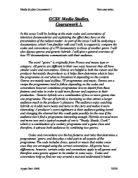I have watched and studied two very different types of documentaries, ‘The Blue Planet’ – an investigative documentary about life in the sea and ‘The Plague’, which is a kind of historical docusoap about the disease that wiped out millions in the 17th Century. The former, which I thought was by far the best, was extremely informative on the mysteries of ocean life. A very experienced narrator (David Attenborough) led the audience through the various nature programs. The film they captured was obviously the result of months of filming using very up to date camera equipment. As I have said the program was very informative but it was also very entertaining at the same time. This was achieved by using varied music and sound affects at the right time. For example if a particular creature were quite amusing, comical music would be added for a greater affect. The amazing camera work, which I have already mentioned, also helps to keep the audience amused because it made you feel like you were actually in the water with the creatures. The camera was used very affectively throughout the programme, they used a lot of tracking when filming the moving animals and a lot of graphic matching, this must have gone unnoticed because almost all the filming was done under the sea. I also thought the shots above the water were effective because they showed the vastness of the sea. The sound also helped to make it seem like we were there because we could hear every single movement in the water of the fish that were being film.
The latter named “The Plague” was also highly appealing, however entirely different methods were used to keep the audience watching with interest. Actors were employed to aid the making of the documentary to make it more realistic and entertaining and only secondary resources were available. The documentary focused on one back street during the plague epidemic. Narrator John Peel introduced each of the characters.
A similarity that I did notice was the use of realism and p.o.v shots used in both documentaries, however in “The Plague” we saw several scenes through a kind of mask. I found that “The Plague” was very graphic and I think this was done to make the audience react to appeal to the audience’s emotions and senses. The whole film had a dirty and sick feeling to it and I think this was because of the setting. It was always dark and special effects were used when writing came up on the screen, it was also the type of font we would associate with that period in history. All the filming took place in a dirty, muddy back street, with shots of people coughing frequently shown. Unlike “The Blue Planet” we were told numerous facts and statistics about the plague. This was not the only difference between the two; the camera work was very divergent. During “The Plague” there were lots of close up shots of peoples faces; vermin running through the streets.
Both the documentaries are presented in quite a formal way, but are presented in quite a formal way, but I think “The Plague” is slightly more so. I think “The Blue Planet” comes across as very impressive and spectacular – probably to make the audience “ooh” and “arr” and this is achieved. It was also very much eye candy for us. It consisted of many things we had never seen before, and if we had seen them they had never been film like that in any other programme. Although there have been hundreds of nature documentaries I think this one was very original. “The Plague” documentary was not quite so original, and rather than amazing us like “The Blue Planet” it had more of a tendency to disgust the audience.
The two documentaries are presented in totally different ways “The Blue Planet” was glorified and consisted of excellent camera work, whereas “The Plague” gave us a easy to understand factual piece about a historical event. Using actors performing very graphic film. Although the camera work was good a lot of the same shots were filmed and this undoubtedly bored the audience.







